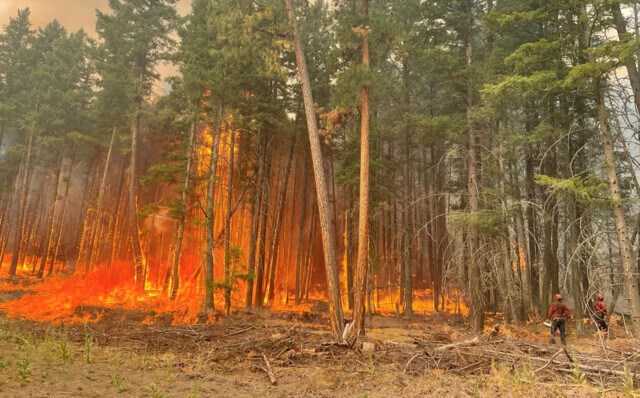Again, in 2021, record-breaking wildfires burned in British Columbia, fuelled by the heat dome, drought, wind and excessive forest fuels. Our homes and communities are vulnerable – flammable structures surrounded by forests and mountains with limited evacuation routes made even more hazardous by thick smoke. Entire communities have burned – businesses, homes and, tragically, lives lost. The cascading effects of torrential rain on burned and exposed mountainsides contributed to the catastrophic floods that severed transportation routes and further disrupted lives and livelihoods.
The costs are in the billions of dollars, without accounting for the indirect price of trauma and smoke on human health or damages to drinking water and wildlife habitat. Again, we find ourselves calling for urgent transformation of forest and fire management to reconfigure our forests and communities to be resilient to wildfires fuelled by climate change and outdated forest practices.
Record wildfires have also ravaged the western United States — sparking action. Last week, the U.S. Federal Government announced plans to spend USD50B over the next decade on wildfire mitigation. Hundreds of millions of dollars are earmarked for forest thinning and prescribed burning on public lands, incentives for private landowners and support for Indigenous communities to enable fuel treatments, and subsidies for bioenergy products from hazardous fuels. Investments are holistic — buffers around communities called the Wildland-Urban Interface (WUI for short) supported by strategic treatments of surrounding landscapes.
B.C. sits at a crossroads: do we go big and bold like the U.S.? Or, do we continue with the small-scale, individual-WUI approach that has been in place since 2004?
B.C.'s approach has focused on the narrow buffer of land around communities, minimizing costs and impacts on timber supply. Not all communities benefit.
Funding is prioritized on communities with high housing density and in the driest parts of the province – as a result, large communities, often with expensive homes, get the lion's share of the money. And recently, some funding for proactively treating hazardous fuels has been redirected to education efforts to convince homeowners to take more responsibility to FireSmart (RT) their homes and properties. If 100 per cent of the community fully subscribed to FireSmart, and that's a very optimistic scenario, physical homes and businesses could survive a fire, but the "community" would not.
B.C.'s WUI-focused strategy surrenders our landscapes to severe fire effects — as we witnessed in 2017, 2018 and 2021. The costs to our society are mounting, as witnessed here in B.C. and the U.S., Australia, and other places impacted by extreme wildfires.
Each year that hundreds of thousands of hectares of forests burn, B.C. residents and everyone downwind of us will suffer hundreds to thousands of premature deaths every year due to chronic smoke exposure, not to mention premature births and increased incidence of cognitive impairment. Watersheds delivering drinking water will require expensive rehabilitation and secondary water quality treatment. The timber harvesting land base will continue to shrink, resulting in mill closures, unemployment, and increased resource conflicts. Businesses such as agriculture and tourism will suffer from direct and indirect fire damage. Levels of social anxiety, depression and substance abuse will increase. Increasingly, municipal and provincial budgets will be consumed by reactive fire suppression and rehabilitation expenses.
Governments avoid going "big and bold" – it is politically risky. Going "small" spends less money and delivers short-term tangible results within an election cycle. Going "big and bold" requires long-term vision, but the dividends don't accrue until well into the future. But adapting to wildfire is larger than politics — it is the difference between a future with options and opportunities for our children and grandchildren versus a future of very limited options and few opportunities.
Going "big and bold" for B.C. does not mean spending $50B over 10 years. Instead, it requires a significant shift in wildfire and forest management objectives and a change in priorities. The Province needs to heavily invest in WUI hazard reduction and radically shift landscape management from short-term timber supply to long-term resilience of ecosystems, habitats and productivity.
Going forward, we need immediate, sustained, equitable, and large-scale action; we need to go "big and bold."
Robert Gray is an AFE Certified Wildland Fire Ecologist and Dr. Lori Daniels is a Forest Ecologist at the University of British Columbia.





